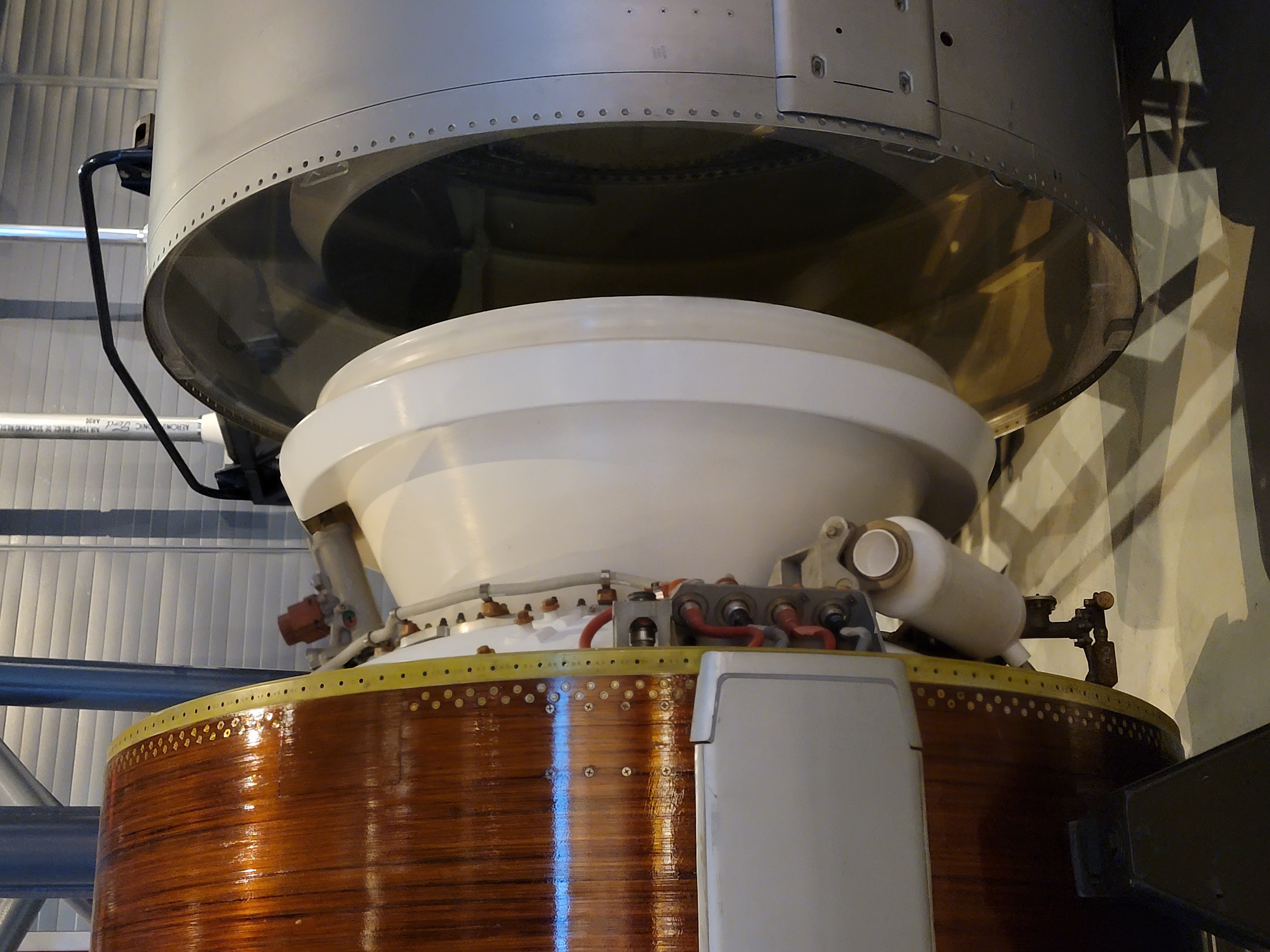|
Adapter (rocketry)
In rocketry, an adapter is a hollow cylindrical or conical segment which provides a sound aerodynamic and structural connection, either between rocket stages (often referred to as an interstage) or between a spacecraft and the top rocket stage (referred to as a payload adapter). It may shroud and protect vulnerable systems such as electrics or machinery of rocket engines/spacecraft from weather or noise caused by running engines. It is discarded during staging. Examples of rocket stages featuring an interstage adapter: * Centaur (second stage of several Atlas-based launch vehicles, from Atlas-Centaur to Atlas V) * S-II and S-IVB (second and third stage of the Saturn V The Saturn V is a retired American super heavy-lift launch vehicle developed by NASA under the Apollo program for human exploration of the Moon. The rocket was human-rated, had multistage rocket, three stages, and was powered by liquid-propel ...) * The Interim Cryogenic Propulsion Stage (ICPS) of SLS Bl ... [...More Info...] [...Related Items...] OR: [Wikipedia] [Google] [Baidu] |
Atlas-Centaur
The Atlas-Centaur was a United States expendable launch vehicle derived from the SM-65 Atlas D missile. The vehicle featured a Centaur (rocket stage), Centaur upper stage, the first such stage to use high-performance liquid hydrogen as fuel. Launches were conducted from Cape Canaveral Launch Complex 36, Launch Complex 36 at the Cape Canaveral Space Force Station, Cape Canaveral Air Force Station (CCAFS) in Florida. After a strenuous flight test program, Atlas-Centaur went on to launch several crucial spaceflight missions for the United States, including Surveyor 1, and Pioneer Pioneer 10, 10/Pioneer 11, 11. The vehicle would be continuously developed and improved into the 1990s, with the last direct descendant being the highly successful Atlas II. Early development Convair, the manufacturer of the Atlas, developed the Centaur (rocket stage), Centaur upper stage specifically for that booster, sharing its pressure-stabilized tank structure. Technical Centaur was the first r ... [...More Info...] [...Related Items...] OR: [Wikipedia] [Google] [Baidu] |
Space Launch System
The Space Launch System (SLS) is an American Super heavy-lift launch vehicle, super heavy-lift Expendable launch system, expendable launch vehicle used by NASA. As the primary launch vehicle of the Artemis program, Artemis Moon landing program, SLS is designed to launch the crewed Orion (spacecraft), Orion spacecraft on a trans-lunar trajectory. The first (and so far only) SLS launch was the uncrewed Artemis I, which took place on 16 November 2022. Development of SLS began in 2011 as a replacement for the retiring Space Shuttle as well as the canceled Ares I and Ares V launch vehicles. SLS was built using existing Shuttle technology, including Space Shuttle Solid Rocket Booster, solid rocket boosters and RS-25 engines. The rocket has been criticized for its political motivations, seen as a way to preserve jobs and contracts for aerospace companies involved in the Shuttle program at great expense to NASA. The project has faced significant challenges, including mismanagemen ... [...More Info...] [...Related Items...] OR: [Wikipedia] [Google] [Baidu] |
Delta Cryogenic Second Stage
The Delta Cryogenic Second Stage (DCSS) is a family of cryogenic-fuelled rocket stages used on the Delta III, Delta IV, and on the Space Launch System Block 1 launch vehicles. The DCSS employs a unique two-tank architecture where the cylindrical liquid hydrogen (LH2) tank carries payload launch loads and forms the upper section. An oblate spheroid tank filled with liquid oxygen (LOX) and the engine are suspended from the LH2 tank and covered by the interstage during initial launch. The DCSS is powered by a single RL10B-2 engine built by Aerojet Rocketdyne, which features an extendable carbon–carbon nozzle to improve specific impulse. The DCSS was designed by the National Space Development Agency of Japan, based on the second stage it developed for the H-IIA rocket. The initial versions for the Delta III were built by Mitsubishi Heavy Industries in Japan. For the Delta IV, production was transferred to Boeing Integrated Defense Systems and later to United Launch Allian ... [...More Info...] [...Related Items...] OR: [Wikipedia] [Google] [Baidu] |
Saturn V
The Saturn V is a retired American super heavy-lift launch vehicle developed by NASA under the Apollo program for human exploration of the Moon. The rocket was human-rated, had multistage rocket, three stages, and was powered by liquid-propellant rocket, liquid fuel. Flown from 1967 to 1973, it was used for nine crewed flights to the Moon, and to launch Skylab, the first American space station. the Saturn V remains the only launch vehicle to have carried humans beyond low Earth orbit (LEO). The Saturn V holds the record for the largest payload capacity to low Earth orbit, , which included unburned propellant needed to send the Apollo command and service module and Apollo Lunar Module, Lunar Module to the Moon. The largest production model of the Saturn (rocket family), Saturn family of rockets, the Saturn V was designed under the direction of Wernher von Braun at the Marshall Space Flight Center in Huntsville, Alabama; the lead contractors for construction of the rocket were ... [...More Info...] [...Related Items...] OR: [Wikipedia] [Google] [Baidu] |
S-IVB
The S-IVB (pronounced "S-four-B") was the third stage on the Saturn V and second stage on the Saturn IB launch vehicles. Built by the Douglas Aircraft Company, it had one J-2 rocket engine. For lunar missions it was fired twice: first for Earth orbit insertion after second stage cutoff, and then for translunar injection (TLI). History The S-IVB evolved from the upper stage of the Saturn I rocket (the S-IV) and was the first stage of the Saturn V to be designed. The S-IV used a cluster of six RL-10 engines but used the same fuels as the S-IVB – liquid hydrogen and liquid oxygen. It was also originally meant to be the third stage of a planned rocket called the C-4, hence the name S-IV. Eleven companies submitted proposals for being the lead contractor on the stage by the deadline of 29 February 1960. NASA administrator T. Keith Glennan decided on 19 April that Douglas Aircraft Company would be awarded the contract. Convair had come in a close second but Glennan did not w ... [...More Info...] [...Related Items...] OR: [Wikipedia] [Google] [Baidu] |
S-II
The S-II (pronounced "S-two") was the second stage of the Saturn V rocket. It was built by North American Aviation. Using liquid hydrogen (LH2) and liquid oxygen (LOX) it had five J-2 engines in a quincunx pattern. The second stage accelerated the Saturn V through the upper atmosphere with of thrust. History The beginning of the S-II came in December 1959 when a committee recommended the design and construction of a high-thrust, liquid hydrogen fueled engine. The contract for this engine was given to Rocketdyne and it would be later called the J-2. At the same time the S-II stage design began to take shape. Initially it was to have four J-2 engines and be in length and in diameter. In 1961 the Marshall Space Flight Center began the process to find the contractor to build the stage. Out of the 30 aerospace companies invited to a conference where the initial requirements were laid out, only seven submitted proposals a month later. Three of these were eliminated after their p ... [...More Info...] [...Related Items...] OR: [Wikipedia] [Google] [Baidu] |
Lockheed Martin
The Lockheed Martin Corporation is an American Arms industry, defense and aerospace manufacturer with worldwide interests. It was formed by the merger of Lockheed Corporation with Martin Marietta on March 15, 1995. It is headquartered in North Bethesda, Maryland, United States. As of January 2022, Lockheed Martin employs approximately 121,000 employees worldwide, including about 60,000 engineers and scientists. Reports from 2024 estimate that Lockheed Martin Corporation (LMT) holds a market cap of around $139.7 billion. Lockheed Martin is one of the largest companies in the aerospace, military support, security, and technologies industry. It was the world's largest defense contractor by revenue for fiscal year 2014.POC Top 20 Defence Contractors of 2014 . Retrieved: July 2015 ... [...More Info...] [...Related Items...] OR: [Wikipedia] [Google] [Baidu] |
General Dynamics
General Dynamics Corporation (GD) is an American publicly traded aerospace and defense corporation headquartered in Reston, Virginia. As of 2020, it was the fifth largest defense contractor in the world by arms sales and fifth largest in the United States by total sales. The company is a ''Fortune'' 100 company and was ranked in 2022. Formed in 1952 with the merger of submarine manufacturer Electric Boat and aircraft manufacturer Canadair, the corporation today consists of ten subsidiary companies with operations in 45 countries. The company's products include Gulfstream business jets, and nuclear-powered submarines, guided-missile destroyers, M1 Abrams tanks, and Stryker armored fighting vehicles. In 2024, General Dynamics had worldwide sales of $47.7 billion and a workforce of approximately 117,000 full-time employees. The current chairman and chief executive officer (CEO) is Phebe Novakovic. History Electric Boat General Dynamics traces its ancestry to John Philip ... [...More Info...] [...Related Items...] OR: [Wikipedia] [Google] [Baidu] |
Atlas V
Atlas V is an expendable launch system and the fifth major version in the Atlas (rocket family), Atlas launch vehicle family. It was developed by Lockheed Martin and has been operated by United Launch Alliance (ULA) since 2006. Primarily used to launch payloads for the United States Department of Defense, NASA, and commercial customers, Atlas V is the longest-serving active rocket in the United States. Each Atlas V vehicle consists of two main stages. The First stage (rocketry), first stage is powered by a single Russian-made RD-180 engine that burns kerosene and liquid oxygen. The Centaur (rocket stage), Centaur upper stage uses one or two American-made Aerojet Rocketdyne RL10 engines that burn liquid hydrogen and liquid oxygen. Strap-on booster, Strap-on Solid rocket booster, solid rocket boosters (SRBs) are used in several configurations. Originally equipped with AJ-60A SRBs, the vehicle switched to Graphite-Epoxy Motor (GEM 63) boosters beginning in November 2020, except for ... [...More Info...] [...Related Items...] OR: [Wikipedia] [Google] [Baidu] |
Launch Vehicles
A launch vehicle is typically a rocket-powered vehicle designed to carry a payload (a crewed spacecraft or satellites) from Earth's surface or lower atmosphere to outer space. The most common form is the ballistic missile-shaped multistage rocket, but the term is more general and also encompasses vehicles like the Space Shuttle. Most launch vehicles operate from a launch pad, supported by a launch control center and systems such as vehicle assembly and fueling. Launch vehicles are engineered with advanced aerodynamics and technologies, which contribute to high operating costs. An orbital launch vehicle must lift its payload at least to the boundary of space, approximately and accelerate it to a horizontal velocity of at least . Suborbital vehicles launch their payloads to lower velocity or are launched at elevation angles greater than horizontal. Practical orbital launch vehicles use chemical propellants such as solid fuel, liquid hydrogen, kerosene, liquid oxygen, ... [...More Info...] [...Related Items...] OR: [Wikipedia] [Google] [Baidu] |
Rocket
A rocket (from , and so named for its shape) is a vehicle that uses jet propulsion to accelerate without using any surrounding air. A rocket engine produces thrust by reaction to exhaust expelled at high speed. Rocket engines work entirely from propellant carried within the vehicle; therefore a rocket can fly in the vacuum of space. Rockets work more efficiently in a vacuum and incur a loss of thrust due to the opposing pressure of the atmosphere. Multistage rockets are capable of attaining escape velocity from Earth and therefore can achieve unlimited maximum altitude. Compared with airbreathing engines, rockets are lightweight and powerful and capable of generating large accelerations. To control their flight, rockets rely on momentum, airfoils, auxiliary reaction engines, gimballed thrust, momentum wheels, deflection of the exhaust stream, propellant flow, spin, or gravity. Rockets for military and recreational uses date back to at least 13th-century China. ... [...More Info...] [...Related Items...] OR: [Wikipedia] [Google] [Baidu] |









